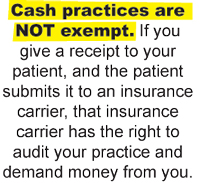The Center for Medicare and Medicaid Services (CMS) employed a Recovery Audit Contractor to run a 3 year demonstration project from 2005 to 2008 in California, Florida and New York. AFTER paying the contractor and including all other associated costs, CMS had a NET return on investment of $373.00 for every one dollar spent on audits. This program has been so successful for CMS that, by the end of 2010, it will be permanent and expanded to all 50 states. It means that, if you work with Medicaid or Medicare, the auditor is coming.
 But this is NOT the end of the story. The rest of the insurance industry has seen the benefit of doing post payment audits, so they are jumping on the bandwagon. Both CMS and the private insurance carriers have been hiring and training an army of auditors.
But this is NOT the end of the story. The rest of the insurance industry has seen the benefit of doing post payment audits, so they are jumping on the bandwagon. Both CMS and the private insurance carriers have been hiring and training an army of auditors.
The auditors are going to be looking for discrepancies between your billing and SOAP notes. First, they check to see if every date of service that was billed has a matching date SOAP note. If there is no SOAP note with the same date, you will be accused of fraud for billing for services that you did not provide. Then they will look at the SOAP documentation to determine [1] if it complies with the insurance company policies, managed care contracts, State law, and Federal regulations and [2] if it substantiates “medical necessity”. If anything is not the way they think it should be, you will be told to give back the money they already paid you.
The bureaucrats have gone wild with their requirements, and all of us are stuck having to live up to their standards. It does not matter if they work for some part of the government, were elected or hired, or work for an insurance company. On a daily basis, they are dreaming up new rules and regulations that every practitioner must live by.
Cash practices are NOT exempt. All the State boards have regulations that dictate the contents of your SOAP documentation, and those regulations are revised frequently to agree with, and sometimes exceed, the demands from CMS and the insurance industry. If you give a receipt to your patient, and the patient submits it to an insurance carrier, that insurance carrier has the right, not only by state law but also by court rulings, to audit your practice and demand money from you.
The depth of detail required, and the clarity of understanding the documentation must provide, make it extremely difficult to produce a handwritten record. A proper and bureaucratically approved handwritten record will take a minimum of 15 minutes per note per patient to produce. How many patients can you treat every day if you need to spend 15 minutes per patient on documentation?
Electronic Health Record (EHR) computer programs come to your rescue. The same quality of SOAP note that would take 15 minutes by hand can be produced electronically in a matter of seconds. The right EHR system gives you audit protection. It does not stop the audit from taking place, it just makes sure that you are compliant with all the rules, regulations, laws, and bureaucratic depth of detail requirements in the SOAP note.
Note that the term EHR refers to a complete integrated system that merges SOAP documentation with office management. This is critical to get the maximum audit protection. In a full EHR program, SOAP notes can generate the billing, insuring that the documentation and billing always match, and there is an internal audit report that lets you know if any SOAP notes are missing for specific dates of service. A single entry places data throughout the system, and duplication of effort, such as copying a diagnosis from documentation to billing, is eliminated.
The terms Electronic Medical Record (EMR) or Electronic Clinical Record (ECR) program refer to only the clinical documentation. In the event that EMR/ECR is all that you have, or just separate EMR/ECR and billing programs, then you lose the integration and interactivity that comes with a full EHR system. The result is that you and your staff need to do a lot more work, duplicate many entries, buy and use paper (fee slips, travel cards, etc.), and do not have the audit and collection protections that are built into the full EHR system.
Protect your office today. Use a full EHR program and benefit from all the features it provides. You may not avoid an audit, but you will more than just survive it.
Dr. Paul Bindell, a 1975 Palmer graduate, has been in practice in Rockaway, NJ, since 1976. He lectured on Chiropractic in Brazil and Israel and is a past Chairman of Public Relations for the Northern (NJ) Counties Chiropractic Society. “The Chiropractic Answer” produced by Dr. Bindell in the 1980’s was a cable television program, a newsletter, and a newspaper column. In 1991, Dr. Bindell and his family began Life Systems Software so chiropractors would have computer programs based on real practice. As a consultant, Dr. Bindell is the expert in assisting the profession and individual chiropractors to improve and succeed. Numerous articles have been written by Dr. Bindell and have appeared in several chiropractic journals. Dr. Bindell is available to speak to your group or organization and can be reached by email at [email protected], or you can call Life Systems Software at 1-800-543-3001.
